 +565 975 658
+565 975 658
 info@premiumcoding.com
info@premiumcoding.com
 Monday - Friday, 8.00 - 20.00
Monday - Friday, 8.00 - 20.00
Fluoropolymers are highly valued for their unique properties such as chemical and thermal stability, low surface energy, and low refractive index. These materials have numerous applications in various fields, including new energy, microelectronics, life medicine and many more. Since the 1940s, researchers have developed many high-performance fluoropolymers through free radical polymerization of fluoroalkenes. However, controlled polymerization of fluoroalkenes has been challenging due to the lack of chain-growth regulation and harsh operation conditions (at high-pressure and elevated temperatures, even 1000 atmospheres were used reported by Sokolov et al. from Russian Academy of Sciences) based on free radical polymerization. Despite the development of reversible deactivation radical polymerizations (RDRPs) has provided well-defined polymers, controlled polymerization of fluoroalkenes remains elusive due to their unique reactivities and solubilities.
Since 2018, Polymao research group from the Department of Macromolecular Science and the State Key Laboratory of Molecular Engineering of Polymers at Fudan University has been working on developing photoredox-mediated RDRP systems for the chain-growth control of fluoroalkenes to enable the synthesis of well-defined main-chain fluoropolymers and the structural control of fluoropolymers. While many groups have made progresses in synthesizing well-defined fluoropolymers, side reactions caused by propagating intermediates and reactivities/solubilities issues of fluoroalkenes have limited the molecular weights and selectivity of copolymers. To solve these issues, the development of a robust and simple method that facilitates the facile structural control of fluoropolymers is desirable for advanced material engineering at the macromolecular level.

Figure 1. Controlled radical copolymerization of fluoroalkenes via redox-relay catalysis
Recently, Polymao Group reported a new method for controlled copolymerizations of various fluoroalkenes (hexafluoropropylene, chlorotrifluoroethylene, and perfluoroalkenyl ether) with comonomer (vinyl ethers, vinyl esters and vinyl amides), using a combination of a redox-relay pathway and thermally activated delayed fluorescence (TADF) catalysis under ambient conditions. Using this method, a broad scope of main-chain fluoropolymers with high molecular weights and low disperisties (Mn = 5.8-223.8 kDa,Ɖ < 1.4, Figure 2) was prepared with excellent selectivity at low organocatalyst dosages (loadings down to 5 ppm). In addition, polymers with various sequences (for example, diblock and triblock) and topologies (either brush or branched) were synthesized by integration with different agents and synthetic protocols. Mechanistic studies revealed that the rationally designed organic TADF catalyst displays the unique characteristics of redox-relay-based electron transfer, a long lifetime of delayed fluorescence and fine-tuned electronic properties. The thermodynamically feasible and reversible crossing between photoexcited 1PC* and 3PC* could promote the interaction with an electron donor before relaxing back to the ground state and facilitate structural design to retain proper reactivities for intermediates, where the lack of merging TADF catalysis and electron reservoir in the photoinduced electron transfer-RAFT polymerization afforded main-chain fluoropolymers of limited results. This work is anticipated to find applications in advanced fluoropolymer engineering and provide a rational design concept to achieve challenging polymer synthesis.

Figure. 2 Fluoropolymers synthesized by redox-relay-enabled controlled radical copolymerization
This work was recently reported by Polymao Research Group with a title on “Controlled Radical Copolymerization of Fluoroalkenes by Using Light-Driven Redox-Relay Catalysis”, published online in the Nature Synthesis (DOI: 10.1038/44160-023-00284-9). The first author of this work is Dr. Yucheng Zhao, and Prof. Mao Chen is the corresponding author. This research was supported by the National Natural Science Foundation of China, Shanghai Pilot Program for Basic Research, Science and Technology Commission of Shanghai Municipality, State Key Laboratory of Molecular Engineering of Polymers and Department of Macromolecular Science at Fudan University.
Paper Link: https://www.nature.com/articles/s44160-023-00284-9#citeas
We are looking for and welcome highly-motivated individuals interested in polymer chemistry! We have positions available at different levels. Please contact Prof. Chen (chenmao@fudan.edu.cn) to explore the opportunities.
Get to know us better now!

Wechat:FDUMMers
Search!
Search across our website
Revenant @ 2018 by fudan | All Rights Reserved
Powered by Weicheng

